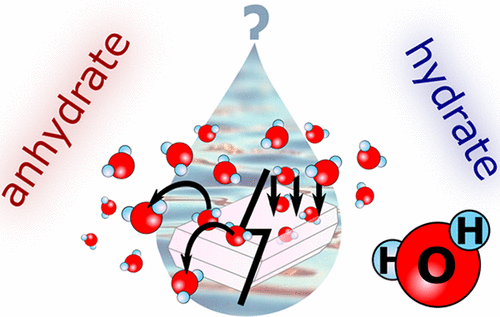当前位置:
X-MOL 学术
›
Cryst. Growth Des.
›
论文详情
Our official English website, www.x-mol.net, welcomes your feedback! (Note: you will need to create a separate account there.)
Toward an Understanding of the Propensity for Crystalline Hydrate Formation by Molecular Compounds. Part 2
Crystal Growth & Design ( IF 3.8 ) Pub Date : 2021-07-30 , DOI: 10.1021/acs.cgd.1c00353 Rana Sanii 1 , Ewa Patyk-Kaźmierczak 1, 2 , Carol Hua 3 , Shaza Darwish 1 , Tony Pham 4 , Katherine A Forrest 4 , Brian Space 4 , Michael J Zaworotko 1
Crystal Growth & Design ( IF 3.8 ) Pub Date : 2021-07-30 , DOI: 10.1021/acs.cgd.1c00353 Rana Sanii 1 , Ewa Patyk-Kaźmierczak 1, 2 , Carol Hua 3 , Shaza Darwish 1 , Tony Pham 4 , Katherine A Forrest 4 , Brian Space 4 , Michael J Zaworotko 1
Affiliation

|
The propensity of molecular organic compounds to form stoichiometric or nonstoichiometric crystalline hydrates remains a challenging aspect of crystal engineering and is of practical relevance to fields such as pharmaceutical science. In this work, we address the propensity for hydrate formation of a library of eight compounds comprised of 5- and 6-membered N-heterocyclic aromatics classified into three subgroups: linear dipyridyls, substituted Schiff bases, and tripodal molecules. Each molecular compound studied possesses strong hydrogen bond acceptors and is devoid of strong hydrogen bond donors. Four methods were used to screen for hydrate propensity using the anhydrate forms of the molecular compounds in our library: water slurry under ambient conditions, exposure to humidity, aqueous solvent drop grinding (SDG), and dynamic water vapor sorption (DVS). In addition, crystallization from mixed solvents was studied. Water slurry, aqueous SDG, and exposure to humidity were found to be the most effective methods for hydrate screening. Our study also involved a structural analysis using the Cambridge Structural Database, electrostatic potential (ESP) maps, full interaction maps (FIMs), and crystal packing motifs. The hydrate propensity of each compound studied was compared to a compound of the same type known to form a hydrate through a previous study of ours. Out of the eight newly studied compounds (herein numbered 4–11), three Schiff bases were observed to form hydrates. Three crystal structures (two hydrates and one anhydrate) were determined. Compound 6 crystallized as an isolated site hydrate in the monoclinic space group P21/a, while 7 and 10 crystallized in the monoclinic space group P21/c as a channel tetrahydrate and an anhydrate, respectively. Whereas we did not find any direct correlation between the number of H–bond acceptors and either hydrate propensity or the stoichiometry of the resulting hydrates, analysis of FIMs suggested that hydrates tend to form when the corresponding anhydrate structure does not facilitate intermolecular interactions.
中文翻译:

了解分子化合物形成结晶水合物的倾向。第2部分
分子有机化合物形成化学计量或非化学计量结晶水合物的倾向仍然是晶体工程的一个具有挑战性的方面,并且与制药科学等领域具有实际相关性。在这项工作中,我们解决了由 5 和 6 元N组成的八种化合物库形成水合物的倾向-杂环芳烃分为三个亚组:线性联吡啶、取代的席夫碱和三足分子。研究的每个分子化合物都具有强氢键受体,但缺乏强氢键供体。四种方法用于使用我们库中分子化合物的无水物形式筛选水合物倾向:环境条件下的水浆、暴露于湿度、水性溶剂滴磨 (SDG) 和动态水蒸气吸附 (DVS)。此外,研究了从混合溶剂中结晶。发现水浆、含水 SDG 和暴露在潮湿环境中是最有效的水合物筛选方法。我们的研究还涉及使用剑桥结构数据库、静电势 (ESP) 图、全相互作用图 (FIM)、和水晶包装图案。通过我们之前的研究,将所研究的每种化合物的水合物倾向与已知形成水合物的相同类型的化合物进行比较。在八种新研究的化合物中(此处编号为4 – 11 ),观察到三种席夫碱形成水合物。测定了三种晶体结构(两种水合物和一种无水物)。化合物6在单斜空间群P 2 1 / a 中结晶为孤立位点水合物,而7和10在单斜空间群P 2 1 / c中结晶分别作为通道四水合物和无水物。虽然我们没有发现 H 键受体的数量与水合物倾向或所得水合物的化学计量之间有任何直接相关性,但 FIM 的分析表明,当相应的无水物结构不利于分子间相互作用时,往往会形成水合物。
更新日期:2021-09-01
中文翻译:

了解分子化合物形成结晶水合物的倾向。第2部分
分子有机化合物形成化学计量或非化学计量结晶水合物的倾向仍然是晶体工程的一个具有挑战性的方面,并且与制药科学等领域具有实际相关性。在这项工作中,我们解决了由 5 和 6 元N组成的八种化合物库形成水合物的倾向-杂环芳烃分为三个亚组:线性联吡啶、取代的席夫碱和三足分子。研究的每个分子化合物都具有强氢键受体,但缺乏强氢键供体。四种方法用于使用我们库中分子化合物的无水物形式筛选水合物倾向:环境条件下的水浆、暴露于湿度、水性溶剂滴磨 (SDG) 和动态水蒸气吸附 (DVS)。此外,研究了从混合溶剂中结晶。发现水浆、含水 SDG 和暴露在潮湿环境中是最有效的水合物筛选方法。我们的研究还涉及使用剑桥结构数据库、静电势 (ESP) 图、全相互作用图 (FIM)、和水晶包装图案。通过我们之前的研究,将所研究的每种化合物的水合物倾向与已知形成水合物的相同类型的化合物进行比较。在八种新研究的化合物中(此处编号为4 – 11 ),观察到三种席夫碱形成水合物。测定了三种晶体结构(两种水合物和一种无水物)。化合物6在单斜空间群P 2 1 / a 中结晶为孤立位点水合物,而7和10在单斜空间群P 2 1 / c中结晶分别作为通道四水合物和无水物。虽然我们没有发现 H 键受体的数量与水合物倾向或所得水合物的化学计量之间有任何直接相关性,但 FIM 的分析表明,当相应的无水物结构不利于分子间相互作用时,往往会形成水合物。


























 京公网安备 11010802027423号
京公网安备 11010802027423号